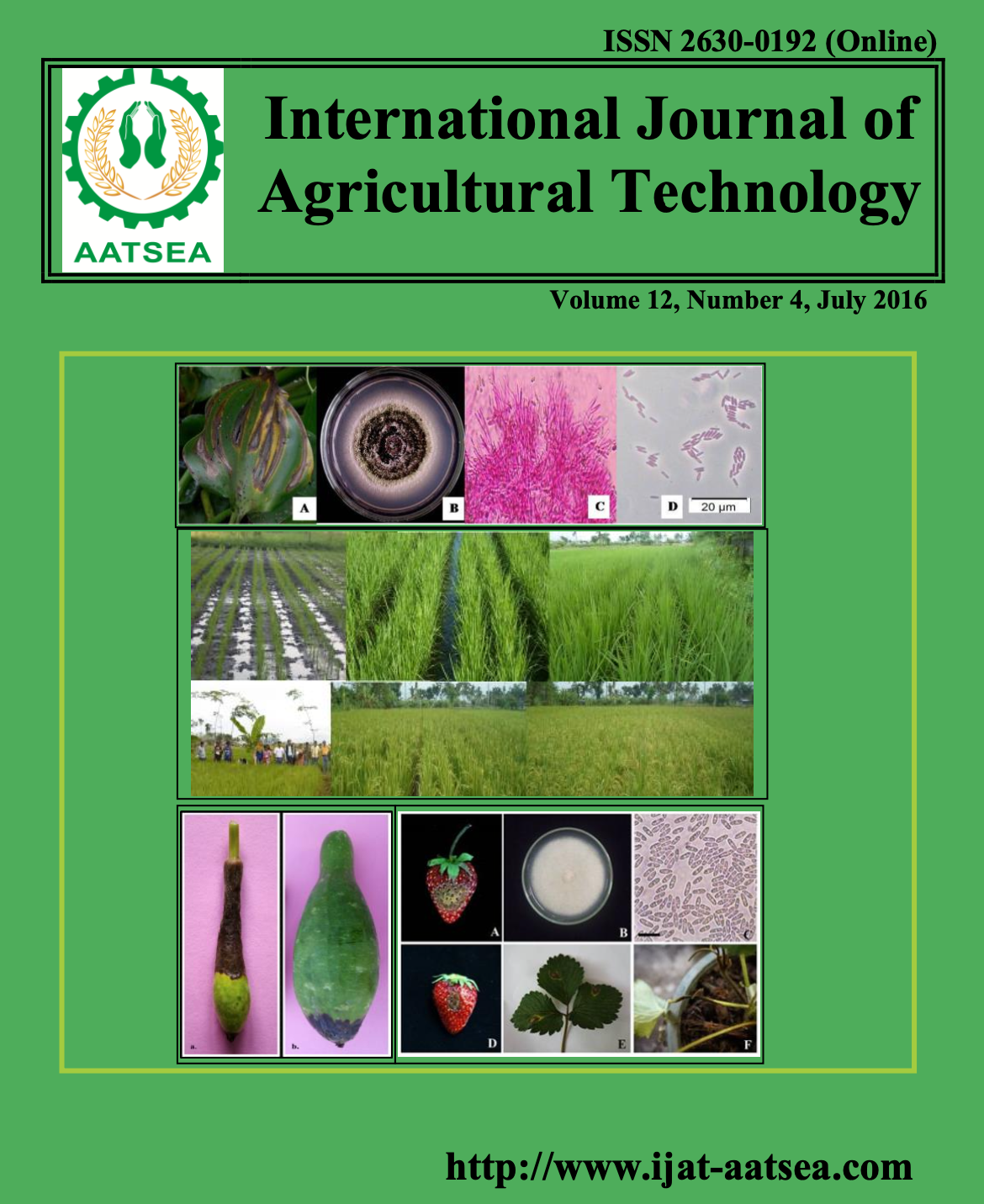Identification of Colletotrichum acutatum and screening of antagonistic bacteria isolated from strawberry in Chiang Mai, Thailand
Main Article Content
Abstract
Strawberry anthracnose is a major disease of cultivated strawberry in the highland area in Chiang Mai, Thailand. This major disease of strawberry fruit is caused by Colletotrichum spp. The symptoms appear as water soaked lesions, which are covered with salmon-colored spore masses. Ten isolates of Colletotrichum spp. were collected from the field at Nonghoi Royal Project, Maehae Royal Project, Samoengs district and Suthep Royal Project Marketing store in Chiangmai, Thailand. The isolates were identified as Colletotrichum acutatum based on morphological characteristics and PCR analysis using specific primers. Pathogenicity tests on fresh strawberry fruit in the laboratory revealed that all the fungal isolates were pathogenic, but C. acutatum isolate CK21 resulted in the most severity symptoms. The isolate CK21 were effuse, first white later becoming orange, then turning into greenish grey as the cultures aged and later become cover with orange to salmon conidial masses and conidia were fusiform. In this study, a total of 105 microbial strains were isolated from fresh strawberry leaves and fruit. They were tested for growth inhibition of C. acutatum isolate CK21 by the dual culture technique on PDA. It was shown that the antagonistic bacterium isolate K27 was found to be the most effective in inhibiting the development C. acutatum isolate CK21 (66.25%). Isolate K27 was identified as Bacillus subtilis. The biocontrol was tested on strawberry leaves by using fresh cells of the bacterial antagonist in greenhouse experiments. The results showed that spaying 1 d before or after the potential the pathogen inoculation significantly suppressed anthracnose compared to the non-treated control. This study suggests of developing bacteria isolate K27 as a biological control of strawberry anthracnose disease.
Article Details

This work is licensed under a Creative Commons Attribution-NonCommercial-NoDerivatives 4.0 International License.
References
Chaur−Tsuen, L. (1998). General mechanisms of action of microbial biocontrol agents. PlantPathology Bulletin 7:155-166.
Denoyes–Rothan, B., Guerin, G., Delye, C., Smith, B., Minz, D. and Maymon, M., (2003). Genetic diversity and pathogenic variability among isolates of Colletotrichum species from strawberry. Phytopathology 93:219-228.
Dionisio, G. A. and Miriam A. A. (2015). The antagonistic effect and mechanisms of Bacillus amyloliquefaciens DGA14 against anthracnose in mango cv. ‘Carabao’. Biocontrol Science and Technology 25:560-572.
Doymaz, I. (2008). Convective drying kinetics of strawberry. Chemical Engineering and Processin 47:914-919.
Doymaz, I., Esitken, A., Yildiz, H. and Ercisli. (2011). Biocontrol of Botrytis cinerea on strawberry fruit by plant growth promoting bacteria. The journal of animal and plant science 21:758-763.
Embaby, E. M. and Amany A. A. (2013). Species identification of Colletotrichum the causal agent of strawberry anthracnose and their effects on fruit quality and yield losses. Journal of Applied Sciences Research 9:3845-3858.
Igor, V. M. (2015). Screening of bacteria of the genus Bacillus for the control of the plant pathogenic fungus Macrophomina phaseolina. Biocontrol Science and Technology 25:302-315.
Irtwange, S. V. (2006). Hot water treatment: A non–chemical alternative in keeping quality during postharvest handling of citrus fruits. Agricultural engineering international: the CIGR–E journal. Invited Overview. 5 pp.
Khleekorn, S. amd Wongrueng, S. (2014). Evaluation of antagonistic bacteria inhibitory to Colletotrichum musae on banana. Journal of Agricultural Technology 10:383-390.
Kuenpech, W. and Akarapisan, A. (2014). Pichia sp. Y2 as a potential biological control agent for anthracnose of Lady’s Slipper. Journal of Agricultural Technology 10:449-457.
Mirko, S. I., Bojan, B. D., Milan, M. I. and Miroslav, S. I. (2007). Anthracnose – A new strawberry disease in Serbia and its control by fungicides. Proceeding of the National Academy of Scienes, Matica Srpska Novi Sad 113:71-81.
Nam, M. H., Kim, H. S., Lee, H. D., Whang, H. G. and Kim, H. G. (2014). Biological control of anthracnose crown rot in strawberry using Bacilus velezensis NSB–1. International Society for Horticultural Science 1049:685-692.
Narongchai, P., Wach, T. and Akagi H. (2008). Strawberry cv. Pharachatan 80, Project of strawberry. Royal Project, Chiangmai.
Panid, N. D. Strawberry. Retrieved from http://coursewares.mju.ac.th:81/-elearning50/ps416/chap_04.html.
Rahman, M. A., Kadir, J., Mahmud, T. M. M., Rahman, R. A. and Begum, M. M. (2007). Screening of antagonistic bacteria for biocontrol activities on Colletotrichum gloeosporioides in papaya. Asian Journal of Plant Sciences 6:12-20.
Sariah, M. (1994). Potential of Bacillus spp. as a biocontrol agent for antracnose fruit rot of chili. Malays. Applied Biology 23:53-60.
Sirinunta, A. and Akarapisan, A. (2015). Screening of antagonistic bacteria for controlling Cercospora coffeicola in Arabica coffee. Journal of Agricultural Technology 11:1209-1218.
Smith, B. J. and Black, L. L. (1990). Morphological, cultural, and pathogenic variation among Colletotrichum species isolate from strawberry. Plant Disease 74:69-76.
Sreenivasaprasad, S., Mills, P. R., Meehan, B. M. and Brown, A. E. (1996). Phylogeny and systematic of 18 Colletotrichum species based on ribosomal DNA spacer sequences. Genome 39:499-512.
Sreenivasaprasad, S. and Talhinhas, P. (2005). Genotypic and phenotypic diversity in Colletotrichum acutatum, a cosmopolitan pathogen causing anthracnose on a wide range of hosts. Molecular Plant Pathology 6:361-378.
Stewart, C. N. J. and Via, L. E. (1993). A rapid CTAB DNA isolation technique useful for RAPD fingerprinting and other PCR applications. BioTechniques 14:748-751.
Svetlana, Z., Stojanovic, S., Ivanovic, Z., Gavriloviv, V. Tatjana, P. and Jelica, B. (2010). Screening of antagonistic activity of microorganisms against Colletotrichum acutatum and Colletotrichum gloeosporioides. Archives of Biological Science Belgrade 62:611-623.
Than, P. P., Jeewon, R., Hyde, K. D., Pongsupasamit, S., Mongkolporn, O. and Taylor, P. W. J. (2008). Characterization and pathogenicity of Colletotrichum species associated with anthracnose on chilli (Capsicum spp.) in Thailand. Plant Pathology 57:562-572.
White, T. J., Bruns, S. L. and Taylor, J. W. (1990). Amplification and Direct Sequencing of Fungal Ribosomal RNA Genes for Phylogenetics. In: Innis, M.A., Gelfand, D.H., Sninsky, J.J., White, T.J. (Eds.), PCR Protocols. A Guide to Methods and Applications. Academic Press Inc., San Diego, pp. 315-322.
Xie, L., Zhang, J., Wan, Y. and Hu, D. (2010). Identification of Colletotrichum spp. isolated from strawberry in Zhejiang Province and Shanghai city, China. Journal of Zhejiang University−science B (Biomedicine & Bio−technology) 11:61-70.


